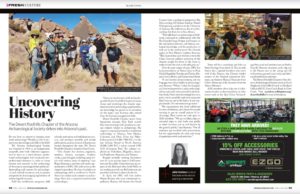The Desert Foothills Chapter of the Arizona Archaeological Society delves into Arizona’s past
The Desert Foothills Chapter of the Arizona Archaeological Society delves into Arizona’s past.
By Julie Carlson
Do you have an interest in learning more about archaeology? Would you like to improve your knowledge and skills in the field?
The Arizona Archaeological Society was founded in 1964 as an independent, non-profit, state-wide volunteer organization to serve as a bond between professional archaeologists and vocational nonprofessional volunteers in order to foster interest and research in the archaeology of Arizona; to encourage better public understanding and concern for archaeological and cultural resources; and, to protect antiquities by discouraging exploitation of archaeological resources.
AAS has certification programs, field schools, restoration and stabilization projects, and produces monthly and annual publications, and much more. Chapters are located throughout the state. The Desert Foothills Chapter is based in Cave Creek.
“Our chapter has doctors, engineers, teachers, lawyers, managers, bankers, cooks, a psychologist, including many artists with various areas of expertise,” says Roger Kearney, a member and media representative of DFC. His wife serves as the chapter’s president. She has a bachelors in anthropology with a certificate in Native American studies and a masters in archaeology. She’s also a registered professional archaeologist.
“Since my involvement with archaeology with Desert Foothills Chapter, between classes and workshops the chapter organized and other archaeology opportunities, my knowledge has grown as an avocation on the topic,” says Kearney, who retired from the business management field.
Desert Foothills Chapter meets from September through May. Each month they have meetings with speakers on various subjects related to archaeology. The chapter is exposed primarily to southwest archaeology of Arizona, New Mexico, Colorado, and Utah. From the Paleo-Indian period (15,000-7000 B.C.) to the late Archaic Period in North America (8,000-1,000 B.C.) and to around 1450 A.D. (Common Era). The cultures explored are Hohokam, Mogollon, Ancestral Puebloans (Anasazi), and Patayan.
Regular monthly meeting discussions start at 7 p.m. and are open to AAS members and the public. Guest lecturers are experts in the field and often hold PhDs or are working toward one. Refreshments are provided and there is often a book sale.
In April, the DFC will host author Wayne Ranney who leads educational expeditions. Ranney will discuss the Grand Canyon from a geological perspective. The May meeting will feature Lindsay Martel Montgomery, a professor at the University of Arizona. She will discuss The Art of Storytelling: Ute Rock Art in New Mexico.
“This talk draws on archaeological fieldwork conducted in collaboration with the Rio Grande Gorge Project and focuses on the interaction between oral history, ecological knowledge, and the production of rock art in the northwestern Rio Grande region in New Mexico,” explains Kearney. “This location has a pre-historical tie to the Chaco Canyon cultural scattering of the Anasazi people for those in the room to make mental ties with as the talk goes on.”
Over the past couple of years, DFC has had presentations on Nazca Lines in Peru, Malta Megalithic Temples and Tombs, Mayan Caves in Belize, and Easter Island Moai.
“A real favorite demonstration, not too long ago, was virtual reality in archaeology,” says Kearney. “When I tried the headgear on, I was transported to a paleo archeological site and could move around the site location freely. I have never knowingly been to a paleo site in actual life and never suspected that I may see one in the future. It was simply fantastic. No one wanted to go home.”
The organization also hosts additional lectures, workshops, and classes for people wanting to get an overall picture of archaeology. These events are only open to AAS members. “We go on hikes, trips, or extended trips to sites both very public or other locations not as well known by the general public,” says Kearney. “Not all members get involved with preservation, but the opportunities do exist, and many do participate with such activities.”
There will be a workshop and hike on Basic Geology from April 12. That month, there’s also a special members only event with Colin Pearson, the Chinese exhibit curator of the Musical Instrument Museum, on Ancient Musical Treasures from China: Harmony of the Ancients from the Henan Museum.
AAS members often help out at information booths or demonstrations at other events such as the Spur Cross Archaeology Fair; mud wall maintenance at Pueblo Grande Museum structure; and a dig site in the Payson area in the spring and fall with pottery, ground stone tools, and lithium identification activities.
The Desert Foothills Chapter of the Arizona Archaeological Society meets at Good Shepherd of the Hills Church in Maitland Hall at 6502 E. Cave Creek Road, in Cave Creek. Visit azarchsoc.wildapricot.org/desertfoothills for more information.
Related posts
Leave a Comment
You must be logged in to post a comment.







